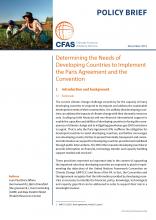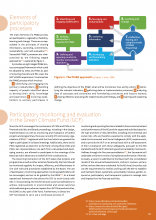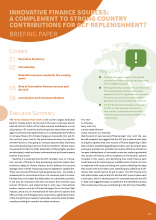Publications / Policy Papers
The international climate finance architecture is a complex landscape in which multilateral development banks (MDBs) play a prominent role. In addition to bilateral climate finance flows, donor countries provide international climate finance directly to MDBs, as well as to multilateral climate funds such as the Green…
>>>
The publication contributes to the increasingly important debate of integrating finance flows for just transition approaches into the global climate finance architecture. In this context, the publication emphasizes the needs for just transition finance of commodity-dependent developing countries. Previously debates on just…
>>>
As part of the Paris Agreement, it was agreed that prior to 2025 a new collective quantified goal (NCQG) should be set from a floor of US$100 billion per year, taking into account the needs and priorities of developing countries. The lessons learned from the process of setting the original climate finance goal of US$100 billion…
>>>
"Making finance flows consistent with a pathway towards low greenhouse gas emissions and climate-resilient development,” also known as Article 2.1c, is of particular importance to the success of the Paris Agreement. It represents one of the three long-term goals of the agreement, while also being a means to achieve the other two long-term goals…
>>>
Since the adoption of the Copenhagen Accord in 2009, international negotiations on climate finance under the United Nations Framework Convention on Climate Change (UNFCCC) have focused primarily on quantitative elements, in particular the amount of financial resources provided over a certain amount of time or the resources allocated to certain…
>>>
The formal negotiations on the post-2025 goal are yet to take off. But taking previous negotiations on climate finance matters into consideration, efforts of navigating all interests towards a satisfying decision should not be underestimated - not to mention the delay already imposed by the COVID-19 pandemic. In light of this, this policy brief…
>>>
Many described the outcomes of 15th Conference of the Parties (COP15) in Copenhagen as insufficient or even disastrous. However, amid them, the agreement to provide USD 100 billion annually in climate finance by 2020 was heralded as an achievement. It is one of the few memorable positives for the 2009 conference, which…
>>>
The current climate change challenge exceeds by far the capacity of many developing countries to respond to its impacts and address the sustainable development needs of their communities. It is unlikely that developing countries can address the impacts of climate change with their domestic resources only. Scaling-up both…
>>>
Monitoring and evaluation (M&E) has involved external experts or stakeholders measuring performance of a project or an activity against preset indicators, using standardized procedures and tools. However, with growing emphasis on participatory approaches towards development, there has been recognition that M&E should also be inclusive…
>>>
The Green Climate Fund (GCF) is the world’s largest dedicated fund for climate action. By the end of this year it will have distributed all USD 10.2 billion of its initial resource mobilisation to over 102 projects in 97 countries, and we hope have raised twice as much again in…
>>>





